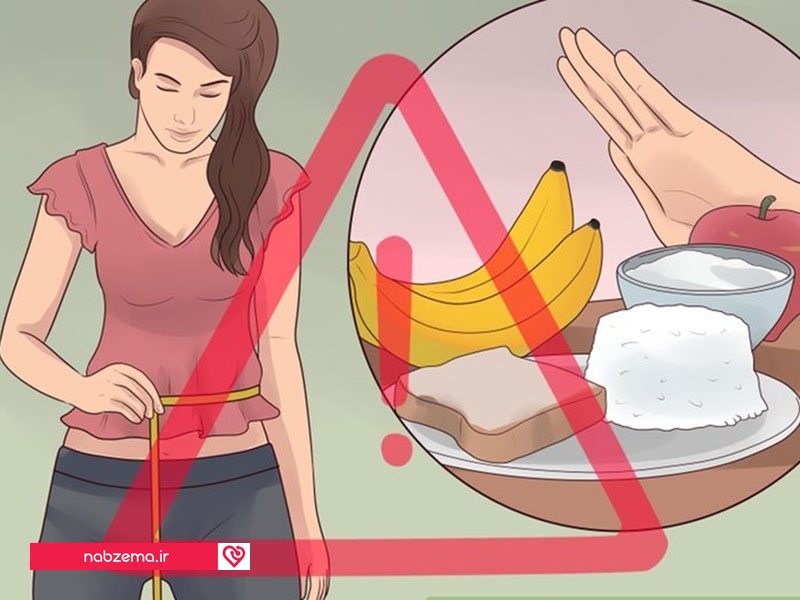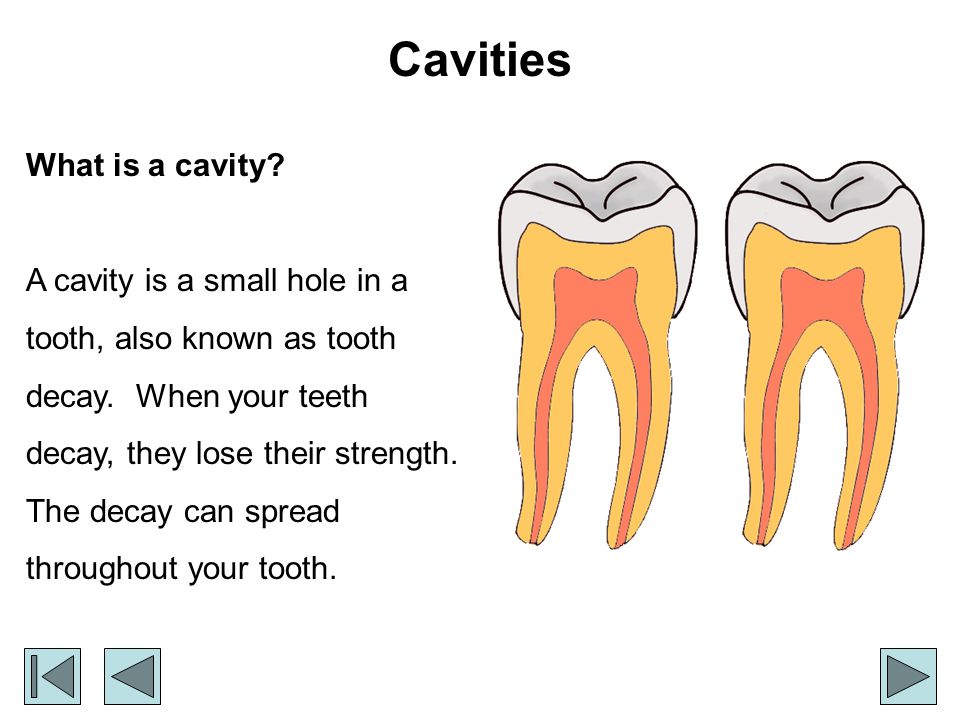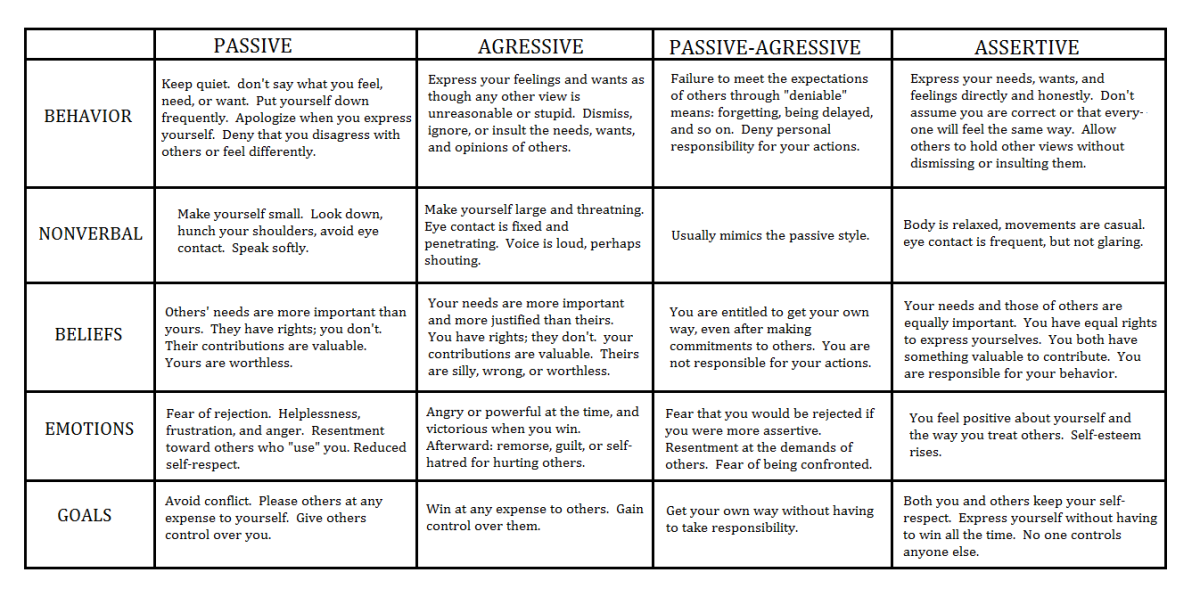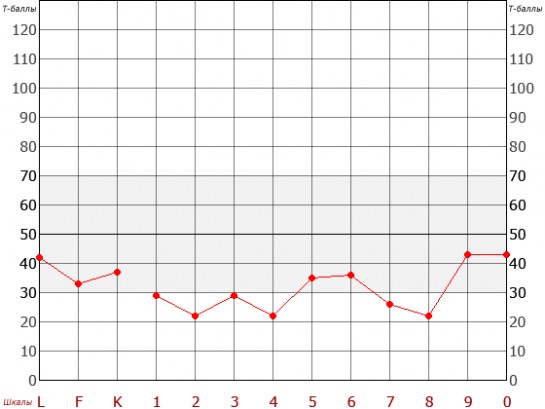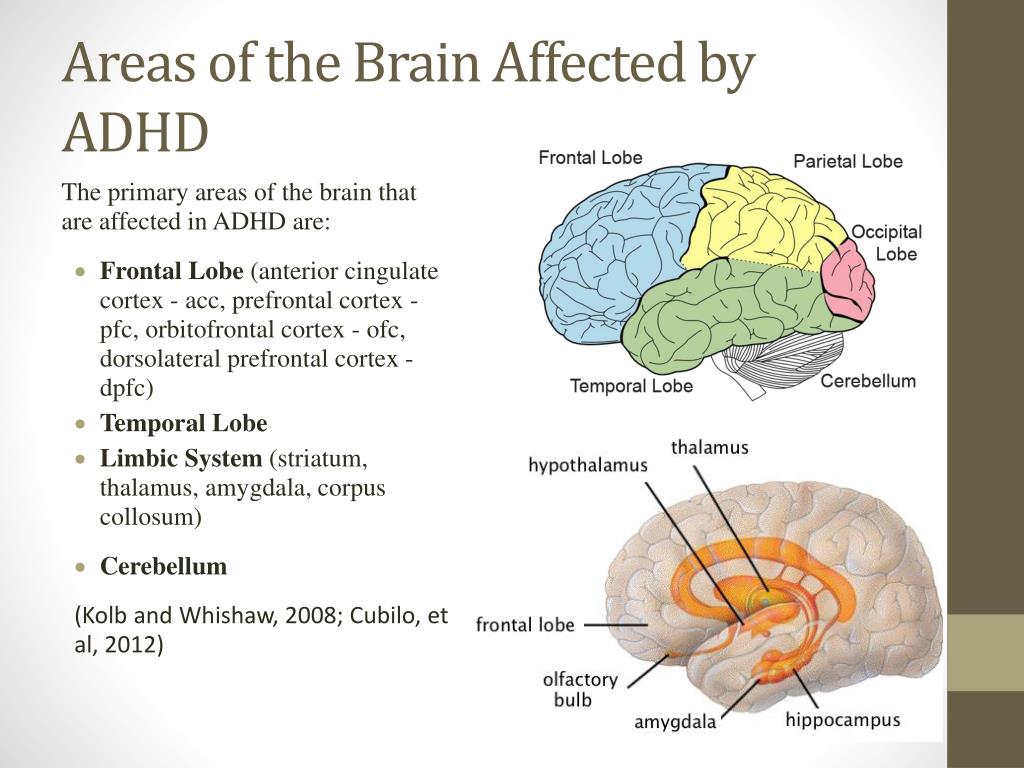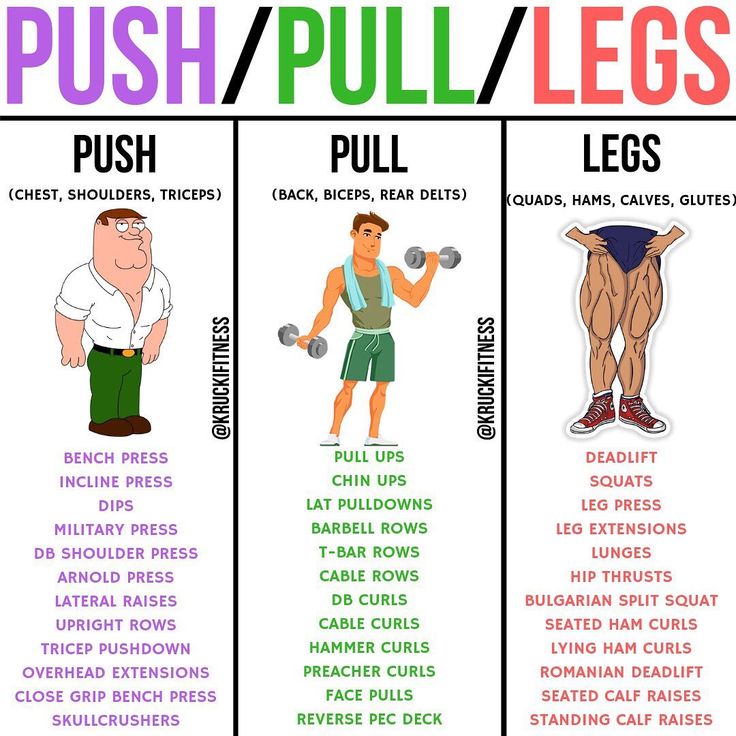Non purging bulimia
Purging vs Non Purging Bulimia | Argyle TX
When most people think of bulimia, they think of one type of eating disorder. That is, they imagine someone who binges on an excessive amount of food in a short time, then purging that food by vomiting or using laxatives. But this sole view of bulimia is in error. In fact, there are multiple types of the condition that a person suffering from drug and alcohol addiction could experience, including the categories of purging vs non-purging bulimia.
About Purging vs Non-Purging Bulimia
Bulimia, called bulimia nervosa by doctors, is a sometimes deadly eating disorder. It involves cycles of eating very large amounts of food in a binge. Then the individual compensates for this eating through behaviors they believe free them from the effects of their binge. Purging is one group of these behaviors, including self-induced vomiting and using diuretics or laxatives.
But another type of bulimia is non purging bulimia. This is a disorder in which you binge but do not purge through vomiting, diuretics or laxatives. Instead, the person with the non purging eating disorder uses other compensatory behaviors, such as diet pills or stimulant drugs, fasting and skipping meals, or obsessively exercising.
Why and How People Commit to Either Type of Bulimia
Bulimia is a disorder that can bring deadly results, all in your desire to control both food and your weight. Dealing with this condition while also battling addiction presents an even greater challenge.
In the purging form of bulimia, you usually privately perform both rituals of the cycle, the binging and purging. But someone with the non purging type of bulimia usually binges privately, then engages in their exercising, extremely disciplined dieting or other non-purging behaviors without concern for what others think of their obsession.
Because the obsessive exercising or other activities are not seen as secretive or “shameful” like vomiting or overusing laxatives, the non purging disorder often proves harder to detect. To outsiders, these people simply seem extremely disciplined in physical fitness or highly conscientious about their diet.
In another comparison of purging vs non purging bulimia, people with both conditions lack self-control during binges. They also both suffer intense guilt and shame after the binge, leading them to think very critical thoughts about themselves. People with these disorders tend to feel self-hatred and disgust.
Even though non purging bulimia looks like healthy dieting or exercise to some people, the condition is as damaging as the purging form of bulimia. The two disorders affect the body in different ways with some similar results, including potential death. Only through simultaneous treatment for purging/non-purging bulimia and addiction can you help yourself or someone you love recover from these co-occurring disorders.
Help for Bulimia and Other Eating Disorders During Addiction Treatment
If you or someone you love suffer bulimia or another type of eating disorder in combination with a drug or alcohol addiction, treatment can help you rebuild life in a healthy relationship with food as you recover.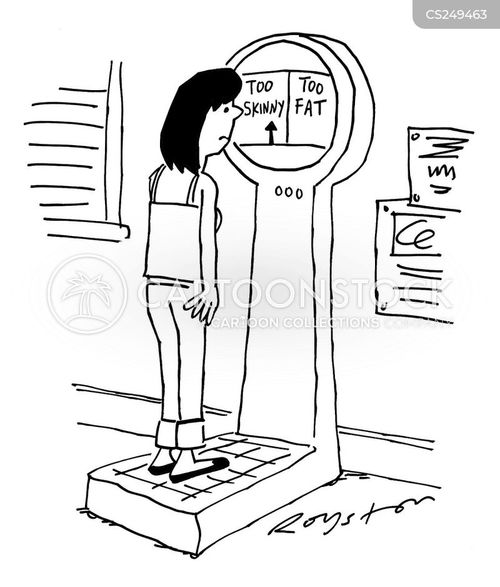 Of course, this treatment must include a range of therapies and programs. The optimum therapies and programs include:
Of course, this treatment must include a range of therapies and programs. The optimum therapies and programs include:
- Dual diagnosis treatment
- Residential and IOP programs
- Nutritional therapy
- Family therapists
- Trauma therapy
- Social activities and alumni program
For help with understanding purging bulimia or non-purging bulimia and how the disorder affects addiction treatment and your life, call Santé Center for Healing in Argyle, TX now at 866.238.3154. You can find your way past co-occurring disorders and to the life you truly want. So call now.
What are the different types of purging and non-purging in bulimia?
- Bulimia Nervosa
- What are the different types of purging and non-purging in bulimia?
- What are the symptoms of bulimia?
- What are the causes and risk factors for bulimia?
- What are the complications of bulimia?
- How is bulimia diagnosed and treated?
- Recovering from bulimia
- Diabulimia - The rise of a new eating disorder associated with type 1 diabetes
Purging is a way to rid oneself of the calories ingested as a part of a food binge.
There are two main types of bulimia:
- Purging type – This kind of bulimia refers to those who will engage in self-induced vomiting or the excessive abuse of diuretics, laxatives, or enemas after bingeing. This type accounts for the majority of bulimia cases.
- Non-purging type – This kind of bulimia refers to the person using other compensatory methods to offset the effects of episodes of bingeing, these include fasting or excessive exercise. In cases such as these, the common types of purging (i.e. vomiting and laxatives) are not regularly used. The excessive use of stimulants or diet pills are also regarded as a non-purging type of bulimia.
The above-mentioned types of bulimia often overlap as sufferers attempt to rid themselves of calories from a binge episode.
Purging type
The main types of purging, accounting for more than 90% of bulimia purging behaviours 4 are:
- Self-induced vomiting
- Overuse/abuse of laxatives and diuretics.

When a bulimic’s well-thought-out method of purging is disrupted, they will typically exhibit emotions of frustration, anxiety and depression as they fear their body will respond to the food binge with weight gain. This body image obsession will drive them to purge soon after a bingeing episode so as to prevent any unwanted calories from staying in their body.
Purging bulimia is characterised by the use of the following methods to eliminate excess caloric intake:
Self-induced vomiting
This may be done by sticking a finger down the throat or using an item such as a toothbrush to activate the gag reflex, both of which result in food returning from the stomach back through the throat and mouth to be expelled.
Abuse of laxatives
Laxatives are typically used when one is constipated and has been for a number of days, resulting in a desperate need to have a bowel movement. However, those with bulimia take laxatives to promote a bowel movement without the presence of constipation.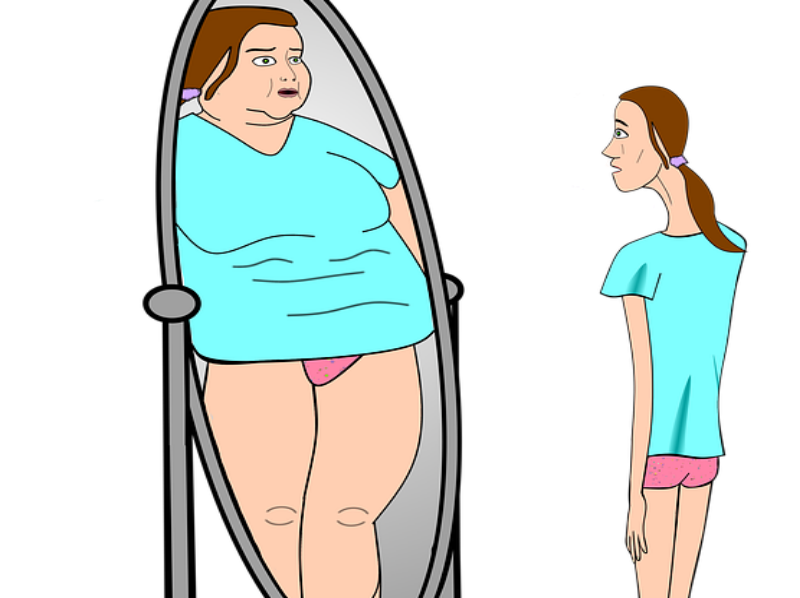
There are two main types of laxatives:
- Stimulant laxatives: These work by artificially stimulating the nerve endings in the large bowel, also known as the colon, this is situated at the end of the digestive tract. This stimulation mimics the natural action performed by the body, informing the colon to empty itself.
- Bulk-forming laxatives: These work by increasing the mass of stools in the digestive tract, to such a point that the bowels will force the stools out.
Diuretics
Diuretics are taken to rid the body of excess fluid and water retention by increasing the rate at which one urinates. Diuretics are also known as water tablets and work through stimulating the kidneys to increase the amount of water and salt that is passed through urine. When the body has too much salt, this can result in excess fluid accumulating in the blood vessels and other areas of the body.
Diuretics are often used as a ‘quick fix’ by those suffering from bulimia to control weight (although the scale weight that is thought to be ‘lost’ is technically just water and will be regained when fluids are consumed).
Enemas
Enemas are another form of treatment for constipation and are used to wash faecal matter that causes discomfort from the bowels. Some bulimia sufferers will give themselves an enema after binge eating. Enema kits can be bought over the counter at a number of pharmacies and are administered by pumping a water solution into the bowel and colon via the rectum. Enemas eliminate faecal build-up by loosening faecal matter within the bowel and eliminating it within minutes.
Non-purging type
Non-purging bulimics employ the following methods to counteract excess calorie intake:
Exercise
Exercise is typically a healthy pastime to perform, this makes it difficult to detect someone who is over exercising and even when this is identifiable, it is not always an indication of bulimia.
Exercise bulimia refers to extreme and pathological exercise that is undertaken in order to counteract the consumption of excessive amounts of food. Those with exercise bulimia will constantly track calories burned during exercise, become anxious or angry if they have missed a workout and defensive or upset if someone mentions that they may be exercising too much.
Those with exercise bulimia will constantly track calories burned during exercise, become anxious or angry if they have missed a workout and defensive or upset if someone mentions that they may be exercising too much.
Fasting
Another non-purging form of bulimia is known as fasting, this is quite rare in those with bulimia and refers to intentionally fasting or abstaining from food after a binge. This can be done for an entire day or longer.
Purging methods and their effect on weight loss
The main aim of purging is to compensate for the act of bingeing in an attempt to deal with the guilt surrounding the calories consumed after eating a large amount of food. However, some experts argue that although methods of purging may prevent some weight gain, the use of laxatives and diuretics are often ineffective in the total prevention of weight gain as laxatives rid the body of waste once food has already been utilised by the body after it travels through the stomach and small intestine, leaving only fibre and other waste matter to pass.
Diuretics aid in ridding the body of excess fluid, this loss of fluid may give the illusion of weight loss, however, it can just as easily be regained through the consumption of food and drinks.
Even self-induced vomiting has shown to only relieve the body of some of the calories ingested as it readily and quickly absorbs the nutrients and vitamins needed from food to be used as energy, regardless of how soon after eating the vomiting takes place.
Studies have shown that even the most successful purging through vomiting will only be able to rid the body of 60% of the calories eaten. This means that the average person purging will only be able to rid themselves of roughly 30% of the calories eaten. This is due to the fact that the process of absorption of food starts in the mouth, it then continues in the oesophagus, and finally, in the stomach. Therefore, even if someone vomits up all of the contents of their stomach, a number of calories have already been absorbed. The same principle pertains to the use of laxatives.
The same principle pertains to the use of laxatives.
Research has shown that vomiting may further encourage the acts of larger quantities of food being eaten when bingeing and overeating, leading to weight gain. The individual suffering from bulimia will have a false sense of security that purging will effectively eliminate all of the calories eaten. This thinking fuels further bingeing and larger quantities of food being binged on.
Fasting has shown to increase cravings and adversely affect one’s mood with little to no effect on substantial weight loss. Weight that is easily lost due to fasting, can easily be regained in a short amount of time. Fasting also slows down one’s metabolic rate, this can make weight gain even faster when normal eating resumes.
Excessive exercise is one of the few methods used to rid bulimics of calories that may lead to weight loss, but this form of non-purging has significant results on one’s health and overall well-being. Some complications of excessive exercise include muscle tears, increased injury risk, a weakened immune system and heart problems.
Some complications of excessive exercise include muscle tears, increased injury risk, a weakened immune system and heart problems.
Those suffering from bulimia need to realise that methods of purging are unable to compensate for the calories eaten, and are, by no means, ways to wipe the slate clean. Both purging and non-purging methods put a great deal of pressure on the body.
References:
4. Journal of Eating Disorders. 2015. Bulimia Nervosa – medical complications. Available: https://jeatdisord.biomedcentral.com/articles/10.1186/s40337-015-0044-4 [Accessed 26.03.2018]
Bulimia: causes and prevention - article "Virmed"
Bulimia is a psycho-emotional disorder associated with eating disorders. The disease is mainly characteristic of women, men rarely experience it.
Clinical and behavioral manifestations
The symptoms of bulimia are not difficult to recognize, but only those around them can notice them, patients do not notice such changes.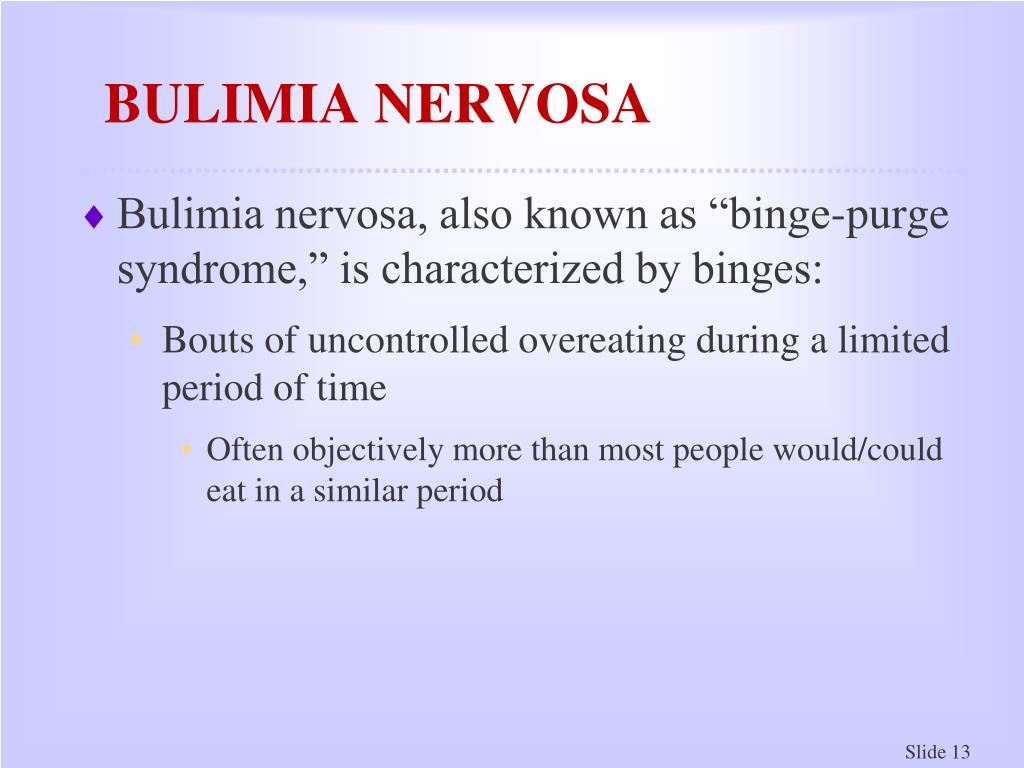 People with this mental disorder are characterized by overeating, during which they do not feel the taste of food, the feeling of satiety also does not occur. After a breakdown, a feeling of repentance arises, during which the patient tries to cleanse his body of the food eaten. To do this, he can mechanically induce vomiting, make cleansing enemas, take laxatives.
People with this mental disorder are characterized by overeating, during which they do not feel the taste of food, the feeling of satiety also does not occur. After a breakdown, a feeling of repentance arises, during which the patient tries to cleanse his body of the food eaten. To do this, he can mechanically induce vomiting, make cleansing enemas, take laxatives.
Girls and women with this disorder are dissatisfied with their weight and appearance in general. Dissatisfaction with oneself leads to breakdowns in overeating. Typically, people with this mental disorder experience the following symptoms:
- dehydration;
- problematic skin;
- inflammation of the esophagus;
- liver and kidney dysfunction;
- weakness, apathy;
- disorders of the digestive system;
- heart disease;
- irregular menstruation;
- frequent sore throats.
Throat diseases are associated with the application of microtrauma to the nails during the provocation of vomiting.
Patients are dissatisfied with themselves, prone to existential emptiness, cognitive and emotional perfectionism.
Causes of the disease
Psychiatrists refer to bulimia as a polymorphic disorder, which can be provoked by many reasons. Both external and internal factors can lead to the development of a disorder, so it is important that the treatment of bulimia is comprehensive and systematic. Experts name the main causes of bulimia:
- psychotrauma, especially if it was received in childhood;
- frequent prolonged stress;
- depressive conditions;
- a change in the usual comfortable environment;
- fear of losing control;
- low self-esteem;
- dissatisfaction with one's appearance;
- perfectionism;
- regular conflicts.
Some pathological changes in the brain can cause uncontrolled overeating, alternating with hunger. Also, the disease often occurs against the background of disruptions in the endocrine system or other mental disorders. Bulimia is more common in emotionally unstable people with low self-esteem and increased responsibility for actions.
Bulimia is more common in emotionally unstable people with low self-esteem and increased responsibility for actions.
There is a category of people who develop a strong appetite during stress, they seem to eat trouble. Persons who do not know how to get out of stressful situations are more prone to bulimia than individuals adapted to them.
Several causes can cause the development of a disorder in one person at the same time. Risk factors include young age, exposure to sexual violence, low self-esteem, and preoccupation with being overweight.
Preventive measures
Preventive measures will help prevent the development of the disease:
- it is necessary to ensure a favorable psychological environment in the family;
- eliminate conflict and stressful situations, depression;
- promptly seek help from nutritionists and psychotherapists if necessary;
- adhere to proper nutrition, exclude starvation;
- play sports;
- give up bad habits.

Psychologists categorically do not recommend parents to force a child to finish eating a portion if he is already full, because this habit will pass with them into adulthood.
Treatment for bulimia lasts 4-8 months on average. With a timely appeal to a psychotherapist and an integrated approach, it is possible to get rid of the disorder in 80% of cases.
ANOREXIA AND BULIMIA - INSIGHT Clinic
"Cruel Marathon" ...
Striving for the ideals of beauty can be disastrous. Any representative of the fair sex wants to be admired by others - and this is quite normal. Today, there are many options to become even more attractive. Probably, the most diverse “methods” have been developed to reduce body weight: the Kremlin diet, the blood type diet, the kefir diet, etc. Being slim and fit is not only beautiful, but also good for overall health. However, sometimes the struggle with extra pounds takes possession of a person so much that it becomes the only goal, the meaning of all life. In the “cruel marathon”, imperceptibly for the “fighter with an extra couple of kilograms”, everything that he aspired to is lost: both beauty and health, the end of a dangerous race can be extremely sad.
In the “cruel marathon”, imperceptibly for the “fighter with an extra couple of kilograms”, everything that he aspired to is lost: both beauty and health, the end of a dangerous race can be extremely sad.
The specialist of the INSIGHT clinic, psychotherapist Tatyana Anatolyevna Koroleva talks about the “fashionable problems” of our time: anorexia and bulimia.
Eating disorders
In medical practice, anorexia is known as a conscious refusal to eat in order to lose weight, accompanied by a strong fear of obesity. This condition is recognized as a disease that is quite severe with a poor prognosis and high mortality. Of all the problems psychotherapists have to face, this is perhaps the most dangerous.
Information note:
Most (90-95%) anorexics are girls and women.
- In the US, anorexia affects 0.5 to 1% of young American women, and those who have subclinical manifestations are much more.
- 5-10% of all anorectics die from exhaustion (this is a very high percentage not only for mental illness, but for any illness in general).
There are three periods in the development of the disease:
- Initial initial stage (dysmorphophobic), which implies "self-denial", that is, a person is extremely dissatisfied with his appearance
- Dysmorphic stage - the desire to change himself
- Cachexia - an extreme degree of exhaustion
Usually people suffering from anorexia achieve weight loss in two ways:
- Restrictions - weight loss through strict diets with a decrease in the amount of food taken every day and excessive exercise.
- Cleansing - that is, by various procedures: gastric lavage, enemas, artificially provoked vomiting after eating.
Main signs of anorexia:
- Progressive weight loss
- Panic about gaining weight
- Denial of maintaining a minimum weight, no matter how low it may be
- Constant feeling of fullness, in particular certain parts of the body
- Not recognizing the feeling of hunger or even its real loss
- Constantly avoiding any situations where you have to eat
- "Special way" of eating: eating standing up, breaking food into small pieces, preferring monotonous meals (only fruits / vegetables / dairy products), avoiding high-calorie foods, self-cooking food "separately for yourself. "
"
- Sleep disturbance.
- Guilt when fasting and eating.
- Isolation from society, depression
- Excessive and disproportionate physical activity
With anorexia, disorders develop at the physiological level, such as pale skin, feeling cold, menstrual irregularities (amenorrhea), heart rhythm disturbances (arrhythmia), constant weakness, and muscle spasms. As well as increased irritability, suspicion, suspiciousness, unreasonable anger, resentment towards others.
Anorexia: a protest against oneself
Many people with anorexia have appetite disturbances and "nutrition problems" from early childhood. In adolescence, the issue of appearance becomes extremely relevant. Increased attention to one's appearance, ridicule of peers, careless remarks of authoritative persons, incorrect statements of envious friends can play a fatal role in the development of anorexia.
This happens, as a rule, in socially very successful "wealthy families.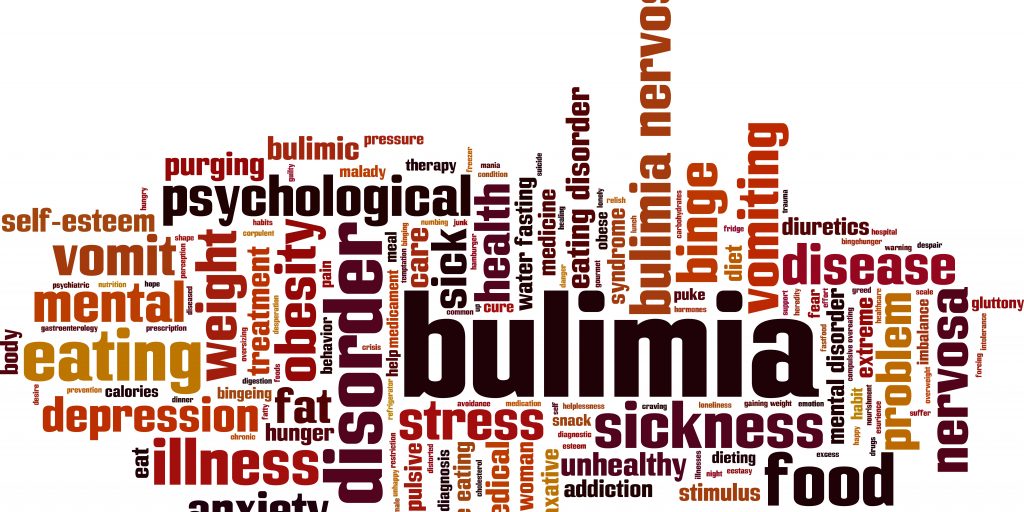 " The "risk group" includes homes where there is a kind of "cult of food", or the opposite approach to nutrition. When a lot is said about the need to limit oneself in food, “so as not to gain weight”, fullness is associated with “rudeness”, “unaesthetic”. Mothers themselves suffer from their own "imperfection" and often resort to various fashionable diets, and also worship everything refined.
" The "risk group" includes homes where there is a kind of "cult of food", or the opposite approach to nutrition. When a lot is said about the need to limit oneself in food, “so as not to gain weight”, fullness is associated with “rudeness”, “unaesthetic”. Mothers themselves suffer from their own "imperfection" and often resort to various fashionable diets, and also worship everything refined.
Anorexia begins gradually. Increased interest and dissatisfaction with one's figure gradually develops into a deep conviction in excessive fullness. A person has thoughts about the need to correct a physical “flaw”, which leads to a restriction in food intake, although the appetite has not yet been lost at this time. Starting with selectivity in food, exclusion of high-calorie foods, gaining momentum in the struggle for harmony, gradually reduce the amount of food eaten, then tighten the diet, eat mainly dairy and vegetable foods. At this stage, body weight decreases by 10-12%, abstinence from food can occasionally be replaced by eating large amounts of food (bulimia).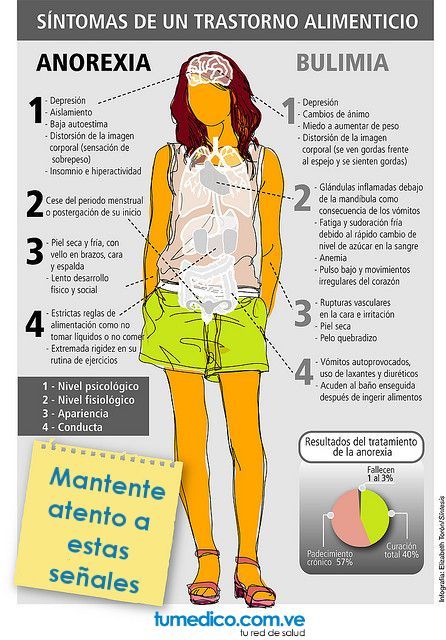
At first, when weight loss meets expectations, mood improves, reaching the degree of euphoria. Girls feel fit, declare an unusual lightness throughout the body. They are lively, sociable, do not feel tired. However, starving people do not seem to notice the negative aspects of their condition: pathological pallor, peeling of the skin, thinning and brittle nails, rapidly developing caries.
The second stage is characterized by an active and stubborn restriction in food, sometimes reaching a complete rejection of food. An external impetus for this can be ridicule or careless remarks of others regarding the figure, advice to lose weight. At this stage, patients actively practice physical exercises: shaping, aerobics, swimming; tend to spend all the time on their feet. Sometimes they induce themselves to vomit or take a laxative. The desire to suppress the feeling of hunger in oneself makes a person resort to various methods (feeding relatives, friends, increased interest in cooking various dishes). A constant decrease in body weight leads to disorders of organs and systems (gastrointestinal tract, cardiovascular system), metabolic processes are disturbed.
A constant decrease in body weight leads to disorders of organs and systems (gastrointestinal tract, cardiovascular system), metabolic processes are disturbed.
The next stage occurs 1-1.5 years after the start of active food restriction. Patients look sharply emaciated, with a sunken face of an earthy color, the subcutaneous fat layer has completely disappeared, pigmented, scaly skin. Trophic ulcers, bedsores, drop in body temperature appear. Sometimes exhausted participants in the “cruel marathon” do not want to see themselves in the mirror, as if they are ashamed of their thinness. Attempts to feed the anorectic cause a violent reaction of protest. A lethal outcome is possible within 2-40%.
Since most hide their starvation, parents are at a loss as to why the child is losing weight so catastrophically. They examine teenagers at endocrinologists, therapists, pediatricians, and since they really develop diseases of the internal organs and endocrine pathology, they can be treated for a long time and unsuccessfully by general medical practitioners. Therefore, parents need to be aware of this violation, and, if there is a loss of body weight, consult a teenager with a psychotherapist, a psychiatrist.
Therefore, parents need to be aware of this violation, and, if there is a loss of body weight, consult a teenager with a psychotherapist, a psychiatrist.
Treatment for anorexia: learning to eat and love yourself
Anorexia is a disease that can cause serious harm to the body and even lead to irreversible consequences. Therefore, it is important to identify the disease as early as possible and seek specialized help before the appearance of irreversible changes in the body. In mild cases, the treatment of anorexia can be outpatient, but more often patients have to be hospitalized due to severe exhaustion. In severe cases, when body weight decreases by 40% or more, immediate forced parenteral feeding (intravenous glucose and nutrient mixtures) is required. Cachexia (stage of extreme exhaustion) is an absolute indication for hospitalization in a psychiatric (psychotherapeutic) clinic.
Patients with anorexia most often do not recognize that they are in danger, and resolutely do not want to be treated.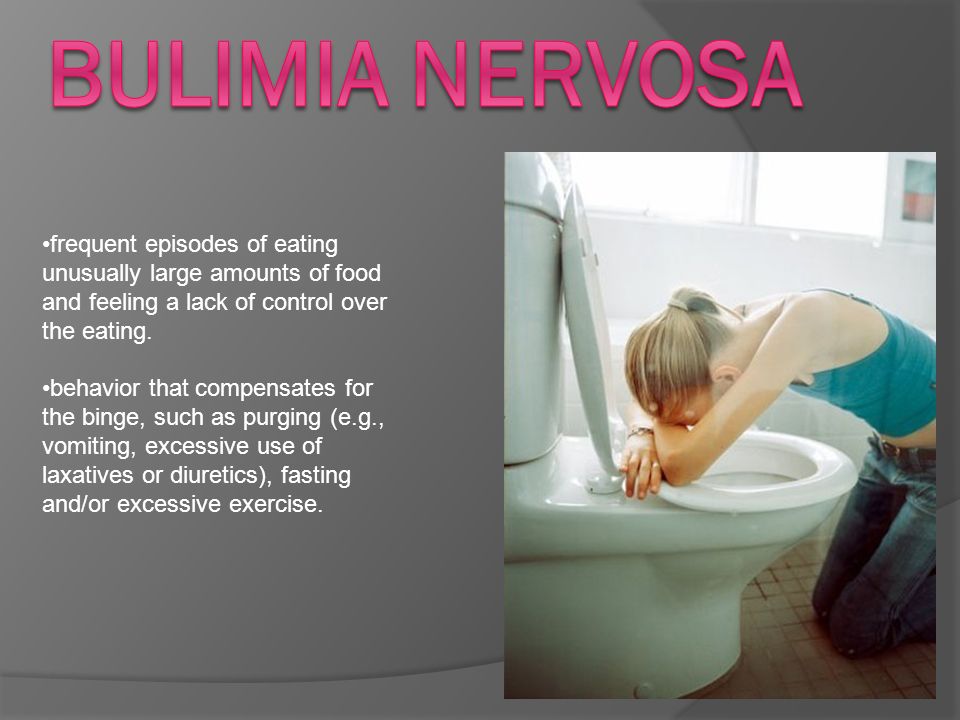 In this they are akin to alcoholics and drug addicts.
In this they are akin to alcoholics and drug addicts.
Treatment of anorexia is carried out in stages. A necessary condition in the treatment of anorexia is psychological support in the form of individual and family psychotherapy: psychological correction of an unhealthy attitude to food intake, the formation of an adequate perception of one's own appearance and the organization of support from relatives
First stage: non-specific treatment
- Improving the physical condition of the patient: after a thorough examination by a therapist and laboratory tests and additional studies, various general strengthening agents, vitamins, blood substitutes, and bed rest are prescribed.
- To overcome the refusal of food, insulin is prescribed, which increases appetite, after which the patient is offered a high-calorie breakfast.
Patients suffering from anorexia are usually prescribed a high-calorie diet with six meals a day.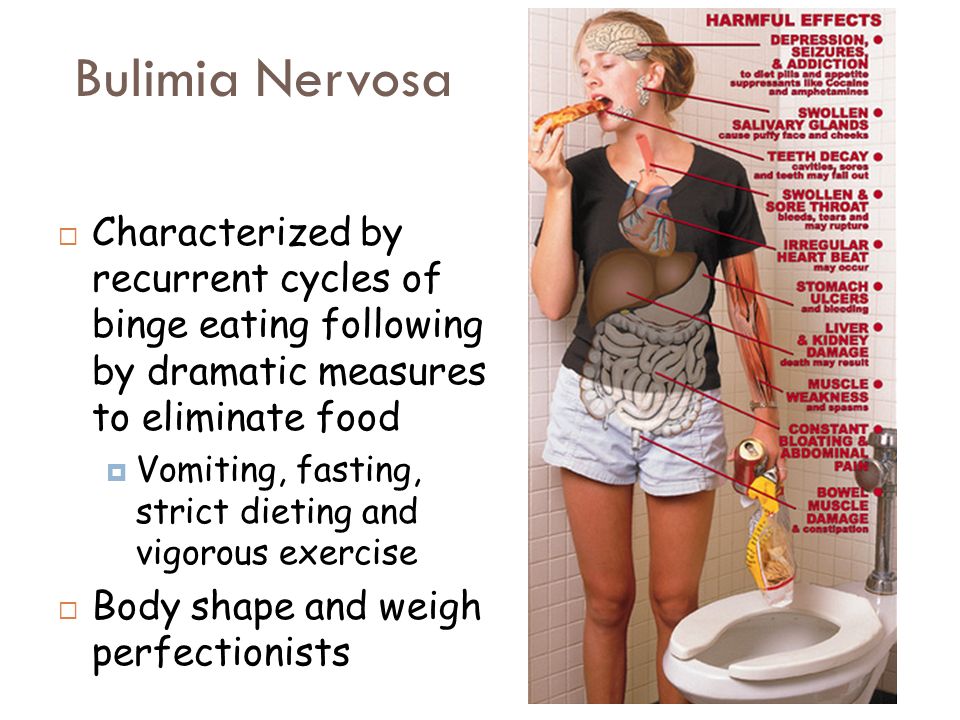 After a few weeks of "non-specific" treatment, an increase in body weight is achieved. It is believed that a weight gain of 2-4 kg over 4 weeks is optimal.
After a few weeks of "non-specific" treatment, an increase in body weight is achieved. It is believed that a weight gain of 2-4 kg over 4 weeks is optimal.
At first, visits with relatives are prohibited, because patients promise to eat at home, insistently demand discharge, and relatives, pitying the patients, begin to insist on discharge. But, premature discharge necessarily leads to a relapse of anorexia.
Second stage: specific treatment
- The patient is transferred to the general mode. Mild tranquilizers and antidepressants are added to the ongoing restorative therapy.
- Rational psychotherapy joins (explanation of the harm of fasting, value reorientation), in some cases hypnosis is effective.
– To eliminate discomfort in the body, sessions of autogenic training can be used.
- Group behavioral psychotherapy at this stage serves as the basis for a positive result and is aimed at eliminating emotional disorders associated with meals, correcting eating behavior, and forming the right attitude towards one's appearance. Group therapy is recommended for such patients, as in the group there is an opportunity to share their problems, communicate with people with a similar painful condition, and get practical advice.
Group therapy is recommended for such patients, as in the group there is an opportunity to share their problems, communicate with people with a similar painful condition, and get practical advice.
- For the success of therapy, it is very important to work with relatives, who are called upon to create the right regimen for patients and monitor their treatment. Group psychotherapy is also provided for relatives.
And at the end of the treatment course, it is obligatory to consult a qualified dietitian and prescribe a dietary regimen in accordance with the characteristics of the patient's body.
A story from the practice of a psychotherapist Tatyana Anatolyevna Koroleva.
It should be noted that in connection with the rule of confidentiality and anonymity of admission, personal data and some details of the biographies of patients have been changed. Any resemblance to real people is purely coincidental.
A middle-aged woman came to the reception, she said that she had been married for a quarter of a century, their family was quite wealthy, she and her husband raised two children who were provided with a good education abroad, but the problem was in their eldest daughter Katya, who had recently begun to abuse alcohol frequently .
Katerina is 24 years old, it was with great difficulty that she was persuaded to come for a consultation. Outwardly, the girl looked constrained, it was difficult for her to express her feelings and emotions.
It turned out that in addition to reduced tolerance to alcohol, Katya still had many unresolved problems. Despite her age, she was not adapted to adult life, she lived with her parents and did not make plans for the future, she had difficulties in contact with peers and loved ones, and, in addition, an eating disorder.
Katya was sure that she was overweight (although outwardly she looked somewhat emaciated) and constantly adhered to a strict diet. As a child, the girl was overweight and sometimes her dad and younger brother made fun of her, now she was sure that her colleagues at work were discussing her “overweight”, and she was very embarrassed by this.
In a difficult struggle against "extra pounds" and other problems that were based on low self-esteem, Katya chose alcohol as her "helper". “At first you begin to feel more confident, then you relax, gradually you forget and stop feeling hungry and thinking about everything that has “accumulated”,” she told about her alcohol “experiments”.
Psychotherapeutic work was aimed at increasing self-esteem, self-acceptance and included the use of antidepressants. After some time, Katya rented an apartment and began to live separately from her parents, gradually entering adulthood, she learned to solve problems in an “adult way”, control her actions, understand herself and communicate with people around her.
Expert comments. Having discovered a problem, relatives often do not know how to convince a person to seek specialized help. Don't hold on to negative beliefs. Try to understand and accept a person with his problem, and most importantly, remind him of your love. Instead of: “you need to see a psychotherapist in order to become normal and eat normally,” you can say that after a psychotherapeutic consultation, your mood will improve and changes in your personal life may occur. A person must himself realize his own problem and ask for help.
In Katya's life there were many prerequisites for the development of addictive behavior. Despite the well-being of the family, she did not feel warmth, love, support, understanding, trust - all that is so necessary for psychological health. The girl lived as if in emotional "isolation", hence the inability to express her feelings, share them, and not the best ways to solve psychological problems. Bulimia or struggle with desires…
A slightly different problem is bulimia, which means “wolf hunger”. Experts regard this condition as a mental disorder, which is based on constant preoccupation with food (frequent talk about weight, calories and diets), fear of gaining weight.
It is believed that bulimia often develops in girls or young women with hysterical character traits. Often, the observance of debilitating diets leads some people not to refuse to eat, but to form a kind of “cult of food”.
Bulimia affects up to 4% of all adolescent girls and young women. Common to all those suffering from bulimia - periods of dieting, passion for gyms, visits to massage parlors, morning jogging, interspersed with periods of gluttony and idleness.
So, in “active periods”, a girl strives with all her might to become perfect, because she is absolutely convinced that she weighs too much, her figure is “obese”, “ugly”, scolds and hates herself for this. Indomitable hunger sometimes makes such people go shopping and "visually eat up." Gradually, thoughts about food take more and more place in life, family, interpersonal and professional problems fade into the background. At some point, nervous tension reaches a peak and the bulimic "breaks down" - "seizes" anxiety and self-hatred.
Bulimics often prepare for meals by making large purchases. All day long, bulimics are starving, constantly looking forward to "lunch", imagining all the nuances of the upcoming meal. When preparing dinner, they experience great pleasure, licking the remnants of food from knives and spoons. Such people usually feed relatives and friends.
At least twice a week, bulimics experience breakdowns - bouts of "gluttony" when they can instantly swallow a huge amount of high-calorie food without chewing or tasting. If other people come or other interference appears, then these actions are interrupted and bashfully hidden.
The feeling of hunger in a typical bulimic attack is so great that they do not think about the consequences - they just eat, eat a lot, so much that the feeling after overeating is very uncomfortable. This is heaviness in the stomach, palpitations, sweating, weakness, up to loss of consciousness, drowsiness and heaviness throughout the body. And most importantly - regret about the perfect, blaming yourself for the lack of willpower, a sense of guilt before yourself. And as a result of all this, a decision was made: to empty the stomach, induce vomiting and another promise to myself never to do this again.
This attempt to compensate for binge eating and self-pity in bulimic sufferers does not resolve any of the problems. Vomiting does not prevent the absorption of even half of the nutrients - and a patient with bulimia can eat up to 2 kg of food in "one sitting." And half assimilated is more than enough for weight gain.
After artificially induced vomiting, a feeling of hunger again arises. And again the struggle with oneself begins - an irresistible desire to eat and shame for one's desire. In addition, the acidic environment of the stomach destroys tooth enamel, disrupts the microflora of the esophagus and oral cavity - this leads to serious problems with the digestive tract in bulimics. The feeling of a "hungry stomach" leads to even greater gluttony, which in turn ends with repeated induction of vomiting until the stomach is completely cleansed. Such a cycle can be repeated several times a week, and in severe cases several times a day.
The "vicious circle" makes the bulimic feel powerless, "trapped". In an attempt to counter this, some bulimics try to lose weight by using diuretics and laxatives. As a result of such experiments, problems with the kidneys and intestines are added to bulimia, but the problem of excess weight remains.
How to break the "vicious circle"? Numerous examples show that independent attempts lead to nothing, the advice of friends and relatives does not work. And it’s impossible to tell the whole truth frankly even to close people, because it’s so embarrassing. The best way is to contact a specialist.
Not everyone develops bulimia - so there is something that gave this disease a chance to manifest itself. Metabolic features, hormonal profile, lack of vitamins - may predispose to the development of bulimia, but the main reason lies in the characteristics of the character, perception of oneself and the world around, especially education and response to stress and problems. And to deal with this is the task of the psychotherapist.
Main signs of bulimia:
- Depression, guilt and self-hatred
- Feeling of lack of self-control
- Unnecessarily strict self-criticism
- Constant need for approval from others
- Distorted ideas about the norm of one's own weight
Severe bulimia (requiring urgent hospital treatment) is characterized by:
- Fluctuation in body weight (5-10 kg up and down)
- Chronic irritation in the throat area
- Muscle fatigue and pain
- Loss of teeth
- Parotid swelling
Unlike people with anorexia, bulimics do not lose body weight as quickly, and may weigh slightly under or even slightly overweight for their height. In those who resort to vomiting, the mucous membrane of the throat, teeth, and esophagus are constantly exposed to acidic gastric contents. Due to this, the throat is often reddened, the salivary glands swell, and the face looks swollen, even fuller than usual.
In those who resort to vomiting, the mucous membrane of the throat, teeth, and esophagus are constantly exposed to acidic gastric contents. Due to this, the throat is often reddened, the salivary glands swell, and the face looks swollen, even fuller than usual.
The desire to "seize" trouble is characteristic of some people who do not suffer from bulimia: for example, during a period of low mood caused by any psycho-traumatic factors. Thus, they seem to be looking for a kind of solace in food, and the worse their mood, the more they eat.
The desire to lose weight in the absence of control over their eating behavior makes such people relatively easy to agree to treatment, but only if there is individual psychotherapy in the course of treatment, you can successfully solve the problem of nutrition, excess weight, and most importantly, gain confidence in yourself and your uniqueness.
Many strive for the ghostly "ideals of beauty" that are artificially created and supported by the film industry, the modeling business, not suspecting what is hidden behind the "fashionable thinness" .